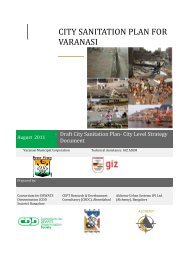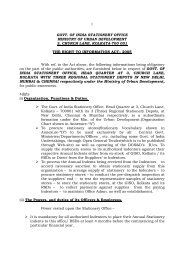City Sanitation Plan, Uttarakhand Detailed Plan report, Muni Ki Reti 1
City Sanitation Plan, Uttarakhand Detailed Plan report, Muni Ki Reti 1
City Sanitation Plan, Uttarakhand Detailed Plan report, Muni Ki Reti 1
You also want an ePaper? Increase the reach of your titles
YUMPU automatically turns print PDFs into web optimized ePapers that Google loves.
<strong>City</strong> <strong>Sanitation</strong> <strong>Plan</strong>, <strong>Uttarakhand</strong><br />
private sector agencies through a series of steps toward achieving the goal of 100 percent sanitation<br />
in the city.<br />
The CSP framework emphasizes that- though apparently linear, the process needs to be highly<br />
iterative and draw in inputs from one series of steps to another. Preparation of city-wide sanitation<br />
plan is an important step in the process. The purpose of the step is to build various scenarios for<br />
technology options and choosing the most suited one. It is important to deliberate on pros and cons<br />
of each option before final selection.<br />
The CSP framework outlines tasks that the States and ULBs will need to undertake:<br />
“States will need to determine time-frames and deadlines to achieve the goals mentioned in the<br />
National Urban <strong>Sanitation</strong> Policy and will need to spell out a detailed roadmap, including the<br />
incremental targets for achievement of goals. For example, to achieve the goal of open defecation<br />
free (ODF) by year 2011, a detailed plan for extending access will need to be formulated and<br />
implemented in a time-bound manner. All such steps will need to be spelt out and operationalzed<br />
under the CSPs. While some of the activities in the sanitation plan may be possible to complete with<br />
little financial resources e.g. better utilization of existing facilities, improved management systems for<br />
septage cleaning, awareness generation; etc. whereas others e.g. reconditioning or laying new<br />
sewers, may be more resource-intensive. The CSP will need to be prepared keeping in view what<br />
the city can afford and finance. It will be better as far as possible to improve the effectiveness of<br />
existing facilities before embarking on expensive new investments. Further, thinking about the whole<br />
city, and not just some portions or just some facilities, will be necessary to achieve the goals in a<br />
comprehensive and systematic manner.”<br />
2.2 Key <strong>Sanitation</strong> Policy Issues<br />
After evaluation of NUSP following key issues have been identified:<br />
2.2.1 Poor Awareness<br />
<strong>Sanitation</strong> has been accorded low priority and there is poor awareness about its inherent linkages<br />
with public health.<br />
2.2.2 Social and Occupational aspects of <strong>Sanitation</strong><br />
Despite the appropriate legal framework, progress towards the elimination of manual scavenging has<br />
shown limited success, little or no attention has been paid towards the occupational hazards faced<br />
by sanitation workers daily.<br />
<strong>Detailed</strong> <strong>Plan</strong> <strong>report</strong>, <strong>Muni</strong> <strong>Ki</strong> <strong>Reti</strong><br />
28
















